LEARN MORE ABOUT THE ANIMALS AT SAFARI LAKE GENEVA
Safari Lake Geneva is home to a variety of wild animal species from all over the world! Learn more about some of our animals below. We also support conservation of vanishing species and heritage breeds of livestock and poultry. Learn more about our conservation partners below.
OUR SAFARI ANIMALS
Safari Lake Geneva is home to a variety of wild animal species from all over the world! Learn more about some of our animals below. We also support conservation of vanishing species and heritage breeds of livestock and poultry. Learn more about our conservation partners below.
ADDAX
Addax nasomaculatus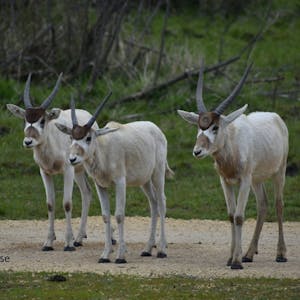
The addax is a critically endangered antelope that was common throughout north Africa until relatively recently. Saving this species from extinction will require a collaborative effort involving numerous stakeholders, including conservation parks like Safari Lake Geneva. The coat of the addax turns nearly white in summer to help reflect the rays of the unforgiving Sahara sun. Their coats become significantly darker in the cooler winter months.
ALPACA
Vicugna pacos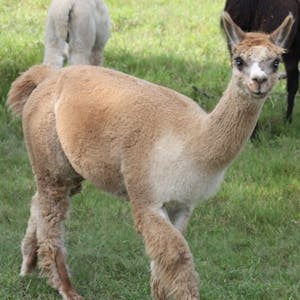
One of the smallest members of the camel family, the alpaca was domesticated in South America by the Incas over 2,000 years ago. Alpaca fiber is seven times warmer than sheep’s wool.
ARABIAN CAMEL
Camelus dromedarius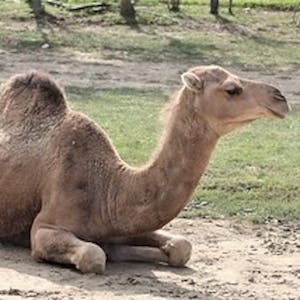
Sporting a single hump, the Arabian camel, or dromedary, is by far the most common of the Old World camels. The Arabian camel today can be found from the west coast of North Africa throughout the Middle East and eastward all the way to India. Although this species can be found living in a wild state in Australia, where it was first introduced in the 19th century, there hasn’t been a wild Arabian camel seen in its original range for almost 2,000 years.
BACTRIAN CAMEL
Camelus bactrianus
Much less common than the Arabian camel, the Bactrian camel can be found from Northeast India through to Western China. It is a close relative of the highly endangered wild camel, that also sports two humps. Owing to its Central Asian origin, the Bactrian camel finds our Wisconsin winters to be rather mild.
BLACKBUCK
Antilope cervicapra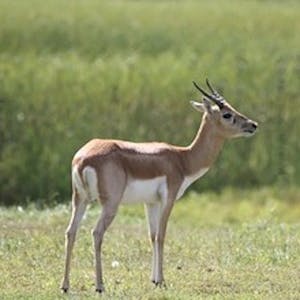
This handsome antelope has the distinction of being one of the fastest land animals anywhere on Earth. The name blackbuck is a reference to the dark, nearly black, color attained by the mature males.
BRAHMAN CATTLE
Bos taurus indicus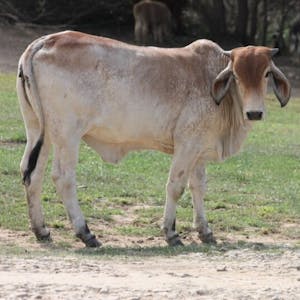
A distinctly American breed, the Brahman was developed primarily from zebu types imported from India over one hundred years ago. The Brahma bull is among the most popular breeds utilized in rodeo bull-riding events.
COMMON ELAND
Taurotragus oryx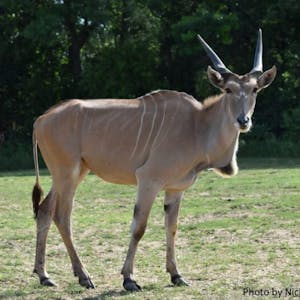
Native to Eastern and Southern Africa, the eland has the distinction of being both the world’s largest and the world’s slowest antelope. Large males may reach a ton in weight, and both sexes sport long, spiral horns. The generally mild-mannered eland has been domesticated for meat and milk production in South Africa and Russia.
EMU
Dromaius novaehollandiae
Among the very largest of the world’s birds, the emu of Australia is incapable of flight. The emu is the only bird on Earth with a double-plumed feather, as opposed to the single, stiff quill of other birds. This gives their feathers a flexible, wispy appearance, which looks more like hair than a regular feather.
INDIAN RUNNER DUCK
Anas platyrhyncos domesticus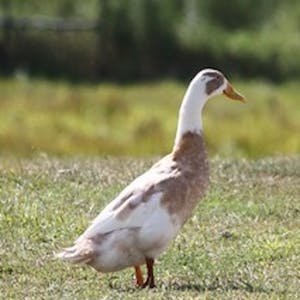
True to its name, this duck stands erect like a penguin and, rather than waddling, runs. Females usually lay 300-350 eggs a year, and sometimes more. Despite its name, the breed appears to have originated in Indonesia.
LLAMA
Lama glama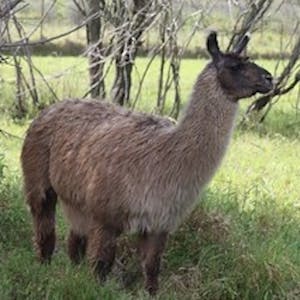
Notably larger than the alpaca, the closely-related llama also has South American origins. Unlike the alpaca, which is primarily raised for its fiber, the llama is used in a wide number of ways, not the least of which being as a pack animal. As the most drama-averse of the camel family, they kindly request you save it for your mama.
LOWLAND NYALA
Tragelaphus angasii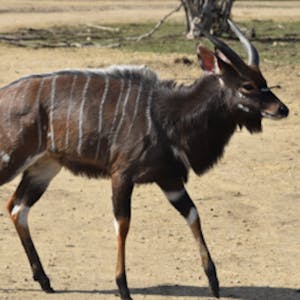
The nyala is a spiral-horned antelope native to the woodlands of southeast Africa. This species may be the most sexually dimorphic of all the antelope; so much so that the male and female could easily be mistaken as representing two different species altogether. Unlike the larger dark brown males, female nyalas are much smaller, rusty orange in color, and lack horns.
MINIATURE DONKEY
Equus africanus asinus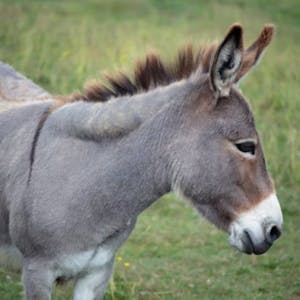
Donkeys were brought from Europe to North America in the 15th century by Christopher Columbus. A descendant of the African wild ass, the donkey was the only African mammal domesticated in ancient times.
MINIATURE HORSE
Equus caballas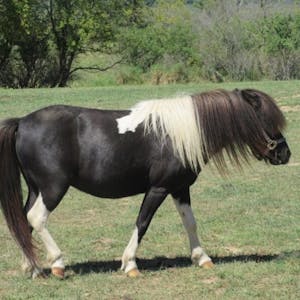
Although it may seem strange to us today to observe bison, camels, and little horses roaming the grasslands right here in Walworth County, this would have been a common sight as recently as 12,000 years ago. Since that time, camels and horses became extinct in North America, though both types of animals flourished elsewhere around the world. The horses you see here today were selectively bred down over many generations from larger breeds in order to navigate the coal mines of Northern Europe, where they were used as a draft animal.
MINIATURE MULE
Equus mule
A mule is the hybrid offspring of a male donkey and a female horse. From the donkey, the mule inherits its intelligence, sure-footedness, toughness, endurance, disposition, and natural cautiousness. From the horse, it inherits speed, conformation, and agility.
MINIATURE ZEBU
Bos taurus indicus
Hailing from the island nation of Sri Lanka, the miniature zebu is only 1/4 the size of the zebu found in nearby India. This animal is much better adapted to hot, humid climates than the European cattle breeds we know and love here in Wisconsin.
NILGAI
Boselaphus tragocamelus
The largest of all the Asian antelope, the nilgai is still found in several parts of the Indian subcontinent. For such a large antelope, its horns are rather small, seldom exceeding ten inches on the males, and typically absent altogether in the females. Its name comes from the Hindi words for “blue” and “cow,” referring to the slate-blue coloration of mature males.
OSTRICH
Struthio camelus
The largest living bird, the ostrich is today found only in Africa, having been exterminated decades ago in the Middle East. Some ostriches exceed nine feet in height, although ours, being female, are considerably shorter. The fastest terrestrial animal on two legs, ostriches have been clocked at a top speed of 43 miles per hour.
PLAINS BISON
Bison bison bison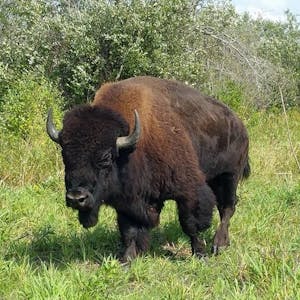
The plains bison once numbered in the tens of millions and could be found in every state in the lower 48 outside of New England, as well as parts of Canada and Mexico. Overhunting nearly exterminated this species in the 19th century, however it is no longer in danger of extinction. The closely-related and slightly larger wood bison is the largest land animal in North America.
PLAINS ZEBRA
Equus quagga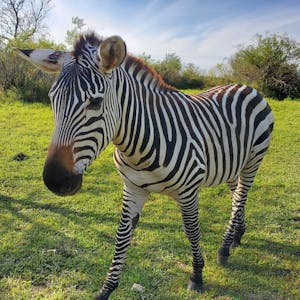
The plains zebra is among the smaller types of zebra, and is native to Kenya and Tanzania. Theories abound as to the purpose of the iconic black and white striping, but many scientists believe it serves to repel flies. Due to their specialized low-protein diet, our guests are not permitted to feed them.
RETICULATED GIRAFFE
Giraffa reticulata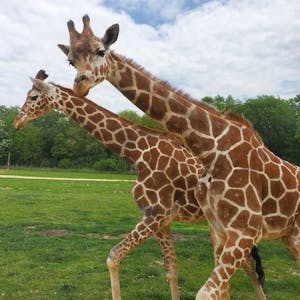
The reticulated giraffe is an endangered species native to eastern Africa. Giraffes are the tallest land animal, with large males exceeding 18 feet in height. By participating in a Giraffe Encounter at Safari Lake Geneva you are supporting the conservation of wild giraffes in Africa. Please note that giraffes may not be visible on rainy days or when the temperature is below 55 degrees.
SCIMITAR-HORNED ORYX
Oryx dammah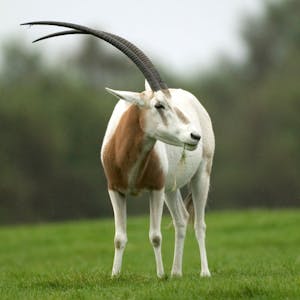
This is the rarest wild animal currently residing at Safari Lake Geneva. As recently as one hundred years ago, it numbered in the hundreds of thousands in Northern Africa, but by the end of the last century it had been exterminated entirely from the wild. In recent years, it has been reintroduced into its native range using individuals raised in parks much like ours. It is so well-adapted to its desert lifestyle, that it can go an entire lifetime never drinking any water, and only obtaining moisture from the plants that it eats.
WATER BUFFALO
Bubalus bubalis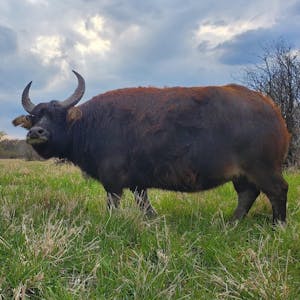
Among the largest, and rarest, hoofed animals on Earth, the wild water buffalo is larger than the wild yak and the bison. The domesticated form, like the ones you may see today, is smaller, and was historically an integral part of the economies of the Far East — so much so that it earned the nickname “the living tractor of the East.”
YAK
Bos grunniens
The wild yak is an enormous creature, even bigger than the plains bison of this country. The domestic yak, like the ones you see here, is much smaller. In its Central Asian homeland, the yak is utilized for milk production, meat, leather, fiber, and as a beast of burden. Even the dung of this versatile animal is used as fuel for the hearth.
OUR CONSERVATION PARTNERS
Safari Lake Geneva supports conservation of vanishing species and heritage breeds of livestock and poultry, both here at the safari park and in the wild. In fact, your visit helps increase our ability to aid in the protection of these animals! One of our primary goals is to raise awareness of the issues that animals face, as well as to educate our guests on the importance of these species in a greater ecological context.
Research indicates the more you know about a species, the more likely you are to care about that species in the wild, which then translates into conservation action. It’s our hope that your visit to Safari Lake Geneva increases your awareness of wildlife and wild places, and that this awareness inspires you to join us in our ongoing efforts to ensure their survival. Learn more about our partners and ways you can help below.
CONSERVATION PARTNERS
Safari Lake Geneva supports conservation of vanishing species and heritage breeds of livestock and poultry, both here at the safari park and in the wild. In fact, your visit helps increase our ability to aid in the protection of these animals! One of our primary goals is to raise awareness of the issues that animals face, as well as to educate our guests on the importance of these species in a greater ecological context.
Research indicates the more you know about a species, the more likely you are to care about that species in the wild, which then translates into conservation action. It’s our hope that your visit to Safari Lake Geneva increases your awareness of wildlife and wild places, and that this awareness inspires you to join us in our ongoing efforts to ensure their survival. Learn more about our partners and ways you can help below.
Safari Lake Geneva not only supports conservation initiatives, but we also participate in surveys and outreach work at home and abroad. We take expeditions to the island of Grenada to conduct long-term monitoring. Grenada is home to only two endemic terrestrial vertebrates, the Grenada dove (Leptotila wellsi) and the Grenada Frog (Pristimantis euphronides). The Grenada Dove is featured on the national emblem and is considered to be a national treasure. The Grenada Frog is virtually unknown. The Grenada frog is listed as critically endangered on the IUCN Red List because of its limited range, poor habitat connectivity and competition with Johnstone’s Whistling Frog (Eleutherodactylus johnstonei). As a cryptic, night-active small grey animal, they can easily go unnoticed. As with other non-charismatic species, these qualities have hindered conservation efforts. In addition to working with the forestry department in Grenada on survey work, this project will include the development of accessible outreach materials to build public awareness of the unique Grenada frog. We hope to contract Grenadian artists and educators to develop culturally appropriate content for an activity book that can be distributed for free.
Because this small frog’s habitat is restricted to high elevation cloud forest in the central highlands, its tenuous future faces assaults from several quarters: 1) loss of habitat, 2) an introduced frog species (Eleutherodactylus johnstonei), 3) a pathogenic fungus Batrachochytrium dendrobatidis (i.e., chytrid) that is wreaking havoc among frog populations worldwide and 4) environmental instability due to climate change.

Fieldwork with the Grenada frog includes marking individuals to better understand basic details like home range, life expectancy and other life history information. We also conduct surveys to determine habitat needs and occupancy, and we collect tissue samples so we can assess population connectivity. We cannot assume that the extent of habitat currently supporting the Grenada frog is stable. Like many amphibians, the Grenada frog has a narrow tolerance range for temperature and moisture extremes. Monitoring microhabitat temperatures and precipitation be critical to understanding environmental requirements.
Amphibians serve in many critical capacities within our ecosystems. Their conservation should be of great importance. Amphibians are currently experiencing mass extinctions and these declines are unprecedented among other groups of animals throughout human history. With the information from this project, we can recommend management efforts to reinforce habitat connectivity, bolster habitat quality and limit development throughout the central highlands of Grenada. This information will prove critical in avoiding catastrophic losses.
With your help, Safari Lake Geneva can continue to support the conservation of the Grenada frog!


Recently hatched Grenada froglet. As direct developers, the tadpole stage is nonexistent and offspring develop directly into froglets inside the egg.
Seafood Watch
Safari Lake Geneva is one of more than 200 Conservation Partners of the Monterey Bay Aquarium Seafood Watch® program. This program empowers consumers and businesses to make choices for a healthy ocean, helping to support diverse marine ecosystems for the future. Using science-based, peer reviewed methods, Seafood Watch® assesses how fisheries and farmed seafood impact the environment, and provides recommendations on which items are best choices, good alternatives, and which ones to avoid.
Seafood Watch® raises sustainable seafood awareness through its consumer guides, website, app, and partnerships with businesses, culinary leaders and conservation organizations across North America and beyond. For more info, visit seafoodwatch.org.


FrogWatch USA
FrogWatch USA is the Association of Zoo and Aquarium’s (AZA) citizen science program which provides individuals, groups, and families opportunities to learn about wetlands in their communities by reporting on the calls of local frogs and toads.
Frogs and toads play an important ecological role, serving as both prey and predator in wetland ecosystems. They’re considered indicators of environmental health. Many previously abundant frog and toad populations have had dramatic population declines in the US and around the world, so it’s essential scientists understand the scope, geographic scale, and cause of these declines. Safari Lake Geneva staff and volunteers contribute to this important data collection effort by monitoring wetlands in our area.
To learn more about this initiative, visit Aza.org/frogwatch. To learn how you can become a FrogWatch USA volunteer with Safari Lake Geneva, email: [email protected].
Giraffe Conservation Foundation
The Giraffe Conservation Foundation (GCF) is the only non-governmental organization in the world that concentrates solely on the conservation and management of giraffe in the wild throughout Africa. Recent research by GCF and partners has shown that there are four different species of giraffe and not only one as previously assumed. Latest estimates by GCF and the International Union for the Conservation of Nature (IUCN) indicate that giraffe numbers have plummeted across Africa by ~40% to <100,000 individuals in the past three decades.
This is due to a number of factors including habitat loss, habitat degradation and habitat fragmentation coupled with human population growth and illegal hunting (poaching). In some areas traditionally regarded as prime giraffe real estate, numbers have dropped by more than 95%. Safari Lake Geneva is proud to support the efforts of GCF in ensuring a sustainable future for all giraffe species. For more info, visit Giraffeconservation.org.


Cheetah Conservation Fund
Founded in Namibia in 1990, Cheetah Conservation Fund (CCF) is the global leader in research and conservation of cheetahs. CCF is dedicated to saving the cheetah in the wild. Cheetahs once ranged across the entire African continent, except for the Congo Basin, and into Asia from the Arabian Peninsula to eastern India. Today, cheetahs are found in only 9% of their historic range and are extinct in their Asian range except for a small population in Iran of about 50 individuals. Most of the reasons for the cheetah’s endangerment can be grouped into three overarching categories:
- Habitat loss, fragmentation and degradation
- Human-wildlife conflict
- Illegal wildlife trade
The majority of wild cheetahs are found outside protected areas, in areas populated by humans. Saving this magnificent animal from extinction requires innovative conservation methods that address the welfare of both cheetah and human populations over large landscapes. CCF has developed a set of programs that work together to achieve this objective. CCF’s programs have effectively stabilized and even increased the wild cheetah population in Namibia. Safari Lake Geneva supports CCF’s efforts to protect this animal from the threat of extinction. Visit Cheetah.org for more info.
Eastern Massasauga Rattlesnake Species Survival Plan
Safari Lake Geneva staff take part in the conservation of a native species, the eastern massasauga rattlesnake (EMR). As part of the EMR’s Species Survival Plan program, staff contribute to research efforts and education and outreach initiatives to help protect this endangered animal.
Eastern massasauga rattlesnakes can be found from the Midwest to New York and Ontario, and are endangered throughout most of their range, including in Wisconsin. Fragmentation of its wetland habitat is the primary factor contributing to the species’ decline. The U.S. Fish and Wildlife Service has listed the eastern massasauga rattlesnake (Sistrurus catenatus) as threatened under the Endangered Species Act.
To learn more about this ecologically important animal and our conservation efforts to protect it, visit Emrssp.org.

